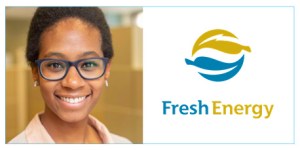Alliance Member Profile: Fresh Energy advancing access and equity

For Fresh Energy, a new program and organization-wide focus is giving power a double meaning.
Since its inception in 1992, the St. Paul-based environmental organization has worked to flip the switch on a clean energy economy for residents across the state. But more recently, its new Energy Access and Equity program is igniting an intentional focus on people power, as well.
In March, Fresh Energy announced the new program aimed at “creating and expanding clean energy opportunities for under-resourced households and renters,” and advance equitable outcomes across Minnesota’s energy system. One way it’s doing that is partnering with another Alliance member organization — Community Stabilization Project (CSP) — on the St. Paul Tenant-Landlord Energy Project.
For Janiece Watts, the Program Associate who’s leading Fresh Energy’s work on the project with CSP, the effort is emblematic of the new focus for Fresh Energy — and other environmental organizations — that actively rejects the false narrative that low-wealth families and people of color don’t care about environmental issues, and intentionally centers the input of those communities who, in fact, have always played a central role in advancing environmental justice.
Through the St Paul Tenant-Landlord Energy Project, Fresh Energy and CSP are building a network of renters, landlords, and other critical stakeholders to advance policies; provide education on energy-related issues; and support implementation of collaboratively developed solutions. “Energy efficiency is an environmental justice issue,” Watts says. “This program is about renters having access and agency in that conversation, and breaking down the power dynamics and communication barriers between renters and landlords.”
The collaboration builds on CSP’s deep connection to community, and their work to educate and organize tenants. Understanding utilities and energy costs is a significant aspect of stable housing, says Carolyn Brown, CSP’s Co-Director. When tenants are in crisis, Brown says, she often asks them to bring in their utility bills, to assess whether energy costs played a role. “And we educate tenants that, even when you move into a place where utilities are included in the rent, you’re still paying for it,” Brown says, “so you might want to ask how much of that rent is going toward energy costs.”
That’s why one of the first steps in the collaboration has been developing an energy toolkit. Because they don’t own the property, renters often don’t know how to approach their landlords — let alone access the energy efficiency programs available to landlords to assist in lowering utility costs. The toolkit aims to be a resource guide that that describes the energy efficiency programs available to renters and landlords, and also ensures tenants understand their rights, like the state Cold Weather Rule, which protects low-income renters from having their heat turned off by the utility or their landlord.
Because of their tireless work to secure housing for local tenants, CSP has built bridges with landlords, as well. Brown says those positive relationships have opened the doors to conversations not only about energy efficient appliances and systems, but also other issues like water conservation.
By engaging with tenants and landlords in a collaborative way, the creation of a toolkit is a first step in creating a “vision of energy justice… in response to climate change and the affordable housing crisis.” To Watts, bringing issues like housing and climate change into the same discussion is critical to advancing equity in a meaningful way. As she wrote in a November blog post:
“Sustainable development and poverty eradication both reduce carbon emissions and tackle inequality. This transformational work can be done with the tools we already have. Through building more pathways to access clean energy, we can ensure that truly no one is left behind in the mobilization to address climate change. We also need to honestly examine how marginalized people and communities have been excluded from these energy innovations and perhaps not unrelatedly, are also being hit hardest by climate change.”
So the toolkit is just one aspect of the larger initiative at Fresh Energy. The Energy Access and Equity program is also working to maximize state programs to reduce the energy burden among low-income families, expand access to solar programs for Minnesotans of all income levels, and bring renters’ organizations into the Minnesota Multifamily Affordable Housing Energy Network.
But Watts emphasizes that equity requires an internal shift in the environmental movement itself — and within Fresh Energy, an organization with few staff and leaders of color. As she explained in her November piece:
“We must also openly recognize that the lack of equity at the foundation of the environmental movement has been a major hurdle to progress on climate change and social justice. These issues negatively build upon each other and are interrelated. This is environmental justice at its core, and it is within this space Fresh Energy will work to reduce the worst impacts of climate change for all of us. This is both a great opportunity and a serious responsibility.”
Learn more about Fresh Energy and its Energy Access and Equity program at http://fresh-energy.org.

You must be logged in to post a comment.